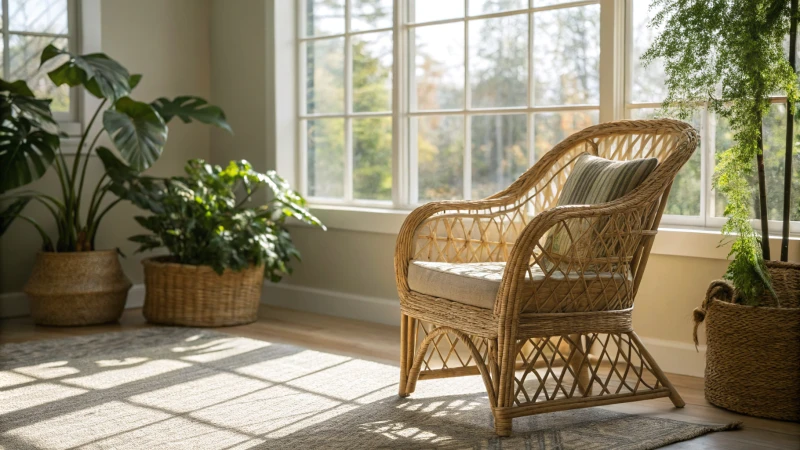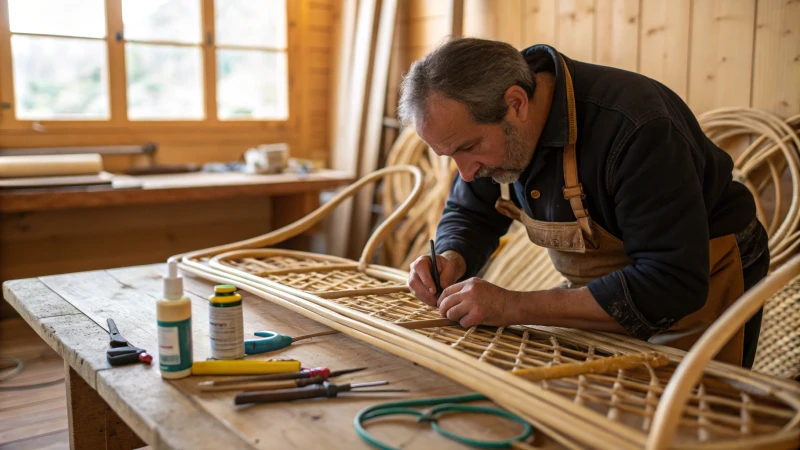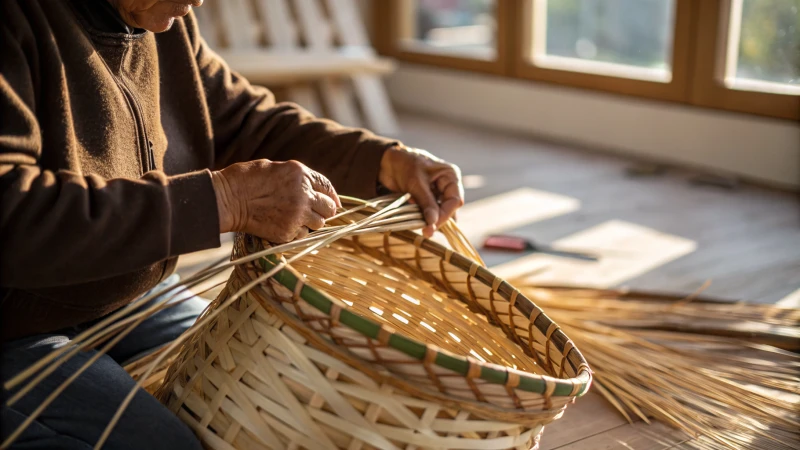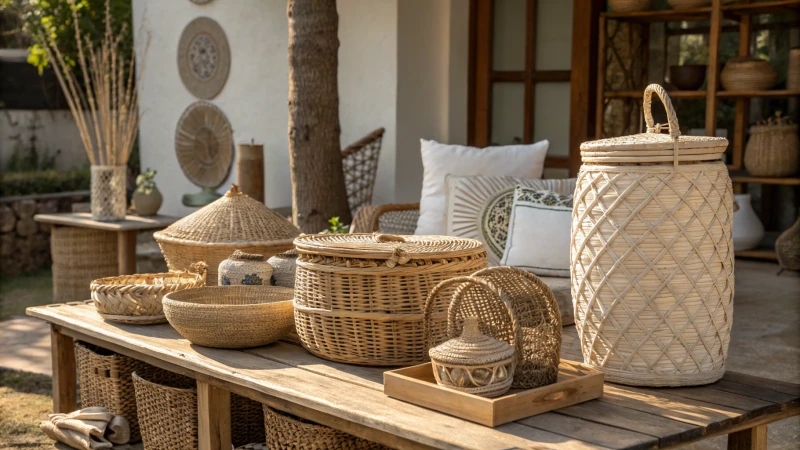
Change your home with DIY rattan furniture!
Find the best tips for DIY rattan furniture projects to improve your home decor and support sustainability. Choose the right materials first. Then, learn weaving techniques. This guide helps you start your rattan crafting journey. Really want to explore the world of rattan crafting? Check the following sections for essential tips, new techniques and inspiring ideas. These will definitely elevate your DIY projects.
I remember the first time I chose to start a DIY rattan project. Creating something beautiful with my own hands brought unmatched excitement! Choosing the right materials proved to be very important. I always search for high-quality rattan that feels nice to handle. Mastering weaving methods required practice. Every twist and turn slowly led me to create something unique. Now, I feel pride each time I sit on a piece I crafted. It really makes me proud!
DIY rattan furniture enhances home decor sustainably.True
Creating rattan furniture yourself promotes sustainability while improving the aesthetics of your living space.
Weaving techniques are unnecessary for rattan projects.False
Mastering weaving techniques is essential for successful DIY rattan furniture making.
What Materials Do You Need for DIY Rattan Projects?
Do you feel excited to start with DIY rattan projects? I remember the joy of my first creation! Let’s look at the materials you’ll need to bring your ideas to life. It’s probably easier than you think!
To start your rattan adventure, gather important items such as rattan cores for structure, weaving strips for design, binding materials for stability and finishing supplies for a smooth look. Get scissors, wire cutters and a hot glue gun for an easy crafting experience.

Crafting Lovely DIY Rattan Projects
To craft lovely DIY rattan projects, gather basic materials. You need:
- Rattan Cores: These are the central stems of the rattan plant. They are sturdy and serve as the primary structure for most rattan furniture.
- Rattan Weaving Material: This includes rattan strips and fibers used for weaving intricate designs. They come in various sizes and thicknesses to suit different projects.
- Binding Material: Often, you will need a strong binding material, such as twine or wire, to secure the rattan pieces together.
- Finishing Supplies: To protect and enhance the natural beauty of rattan, consider sealants or varnishes specifically designed for natural fibers.
Collect these items before you begin; the experience becomes very much easier. Also, remember to have the right tools:
| Tool | Purpose |
|---|---|
| Scissors | To cut rattan strips to desired lengths. |
| Wire Cutters | For cutting binding materials like wire or twine. |
| Measuring Tape | To measure lengths accurately before cutting. |
| Hot Glue Gun | For securing joints and adding decorative elements. |
| Sandpaper | To smooth out rough edges on rattan surfaces. |
Scissors, wire cutters, and a hot glue gun really help; they become your best friends during the project!
Sourcing Sustainable Materials
As an eco-conscious crafter, sourcing sustainable materials is paramount. Here are some tips on where to find quality rattan:
- Local Craft Stores: Often carry a selection of rattan materials suitable for DIY projects.
- Online Marketplaces: Websites like Etsy1 or Amazon2 offer a variety of rattan supplies from different sellers.
- Specialty Rattan Suppliers: Seek out companies that focus on sustainable practices, ensuring your projects align with ethical sourcing.
By prioritizing sustainability, you not only support responsible production but also appeal to eco-conscious consumers like Emily.
Additional Resources for DIY Rattan Projects
For those looking to expand their knowledge and skills in DIY rattan crafting, consider exploring these resources:
- Rattan Weaving Techniques3: This guide covers various weaving methods that can enhance your projects.
- DIY Rattan Furniture Plans: Find detailed plans for creating stunning furniture pieces at home.
- Eco-Friendly Finishing Products: Learn about sustainable finishes that protect your creations while maintaining their natural beauty.
Rattan is a sustainable material for DIY projects.True
Rattan is known for its eco-friendly properties, making it a sustainable choice for crafting furniture and decor.
You need special tools to work with rattan materials.True
Essential tools like scissors and hot glue guns are necessary to ensure precision in DIY rattan crafting.
How Can You Repair and Refurbish Old Rattan Furniture?
Bringing old rattan furniture back to life saves money and refreshes cherished items. Here are some meaningful tips to turn these worn treasures into beautiful parts of your home!
Evaluate the damage on old rattan furniture to repair and refurbish it. Collect tools such as sandpaper, a rattan repair kit and wood glue. Cut loose threads to fix frayed strands and weave in new ones. Apply wood glue on broken pieces and clamp them until they dry. Clean everything thoroughly. Add paint or sealant for a final touch.

Repairing and refurbishing old rattan furniture can be a rewarding DIY project that not only extends the life of your furniture but also adds a personal touch to your home decor.
Assessing the Damage
Before you dive into repairs, it’s essential to assess the condition of your rattan furniture. Look for signs of wear such as:
| Damage Type | Description |
|---|---|
| Frayed Strands | Threads or strands that are coming loose or unraveled. |
| Broken Pieces | Sections of rattan that are cracked or completely broken. |
| Discoloration | Fading colors or stains that affect appearance. |
By identifying the specific issues, you can tailor your repair strategy effectively.
Tools and Materials Needed
To begin the refurbishment process, gather the necessary tools and materials:
- Sandpaper (fine and medium grit)
- Rattan repair kit (includes rattan strands and adhesive)
- Wood glue (for structural repairs)
- Eco-friendly paint or stain (to refresh color)
- Clear sealant (for protection)
Having these items at hand will streamline your repair process.
Repairing Frayed Strands
To fix frayed strands, follow these steps:
- Cut away any loose threads to prevent further unraveling.
- Use the rattan repair kit to weave new strands into place.
- Secure with adhesive to ensure a tight fit.
- Let it dry completely before moving on.
You can find detailed weaving techniques in resources like rattan weaving techniques4.
Fixing Broken Pieces
For broken sections, here’s a guide:
- Remove any damaged pieces carefully.
- Apply wood glue to the broken ends and press them together firmly.
- Clamp until dry to ensure stability.
- If needed, you can reinforce with additional rattan strands.
For step-by-step instructions on clamping techniques, check out effective clamping methods5.
Cleaning Your Rattan Furniture
Cleaning is an important step before refurbishing:
- Use a soft cloth and mild soap solution to wipe down the furniture.
- Avoid soaking the rattan in water, as it can lead to further damage.
- Allow it to dry completely before applying any paint or sealant.
Finishing Touches
Once repairs are complete, consider giving your rattan furniture a fresh coat of eco-friendly paint or stain:
- Choose products that resonate with sustainable practices.
- Apply a clear sealant afterward to protect against moisture and UV damage.
By following these steps, you can successfully restore your old rattan furniture and enjoy its beauty for years to come! For eco-friendly paint options, see sustainable paint solutions6.
Repairing rattan furniture can extend its lifespan significantly.True
Refurbishing old rattan furniture not only enhances its appearance but also prolongs its usability, making it a sustainable choice for home decor.
Cleaning rattan furniture involves soaking it in water.False
Soaking rattan in water can damage it; instead, use a mild soap solution and a soft cloth for cleaning.
What Techniques Should You Master for Weaving Rattan?
Ready to discover the secrets of rattan weaving? Join me on this adventure to explore basic techniques. These will really change your skills and creativity. We will jump into the world of plaiting, twining and coiling together.
To master rattan weaving, focus on techniques like plaiting, twining and coiling. These fundamental skills lead to the creation of various products. They become efficient and beautiful. Creativity grows from these skills. These skills also support sustainable practices.

Understanding the Basics of Rattan Weaving Techniques
Rattan weaving is truly an art that touches my heart. I remember touching a strip of rattan for the first time. It felt strange yet familiar. Its flexibility and strength captivated me and I felt ready for an incredible journey. Learning the rattan weaving techniques improved my craft. It also connected me deeply with the material.
Here are some basic techniques every rattan weaver needs to know:
-
Plaiting: This technique resembles a dance with the rattan strips. I often lose myself in the rhythm of weaving these strips together to create flat surfaces. These surfaces suit baskets or furniture tops. Plaiting offers endless creativity with simple braids or complex patterns.
-
Twining: Twining wraps one strip around another to create a strong yet flexible structure. I crafted some of my most cherished pieces using this method. These include durable chairs and charming storage baskets that now shine in my home.
-
Coiling: Coiling is where the magic truly begins! Spiraling rattan around itself and stitching it together forms beautiful round shapes. These shapes include bowls or decorative items. This technique allows for boundless artistic freedom. Each coiled piece feels like a unique expression of my creativity.
These techniques act as more than skills; they are paths to explore design possibilities that attract eco-conscious consumers.
Tools and Materials for Rattan Weaving
To effectively master rattan weaving, having the right tools and materials is essential. Here’s a table summarizing the basic tools:
| Tool | Purpose |
|---|---|
| Rattan Strips | The primary material used for weaving. |
| Scissors | For cutting rattan to the desired lengths. |
| Weaving Needle | Helps in threading rattan strips during weaving. |
| Tape Measure | For measuring lengths accurately. |
| Clamps | To hold pieces in place while working. |
Using high-quality rattan strips can significantly affect the durability and aesthetic of your finished products. Always choose eco-certified materials to align with sustainable practices in your craft.
Patterns and Styles to Explore
Once you’ve mastered the basic techniques, experimenting with patterns will elevate your work. Here are a few popular patterns to consider:
- Chevron Pattern: This zigzag design adds a dynamic look to your products.
- Herringbone Weave: A classic pattern that offers a sophisticated touch to any piece.
- Basket Weave: Perfect for creating sturdy and visually appealing baskets.
For more intricate designs, studying advanced weaving patterns7 can provide inspiration and techniques to further refine your skills.
Conclusion on Continuous Learning and Community Engagement
Engaging with fellow weavers through workshops or online communities can provide additional insights and encouragement. Explore rattan weaving communities8 for resources, tutorials, and support from experienced artisans.
As you delve deeper into the world of rattan weaving, remember that practice is key. Each technique you master opens up new possibilities for creativity and craftsmanship.
Plaiting is essential for creating flat surfaces in rattan weaving.True
Plaiting involves interlacing rattan strips, crucial for making flat items like baskets and furniture tops.
Coiling is used primarily for making flat surfaces in rattan work.False
Coiling creates round forms by stitching rattan together, ideal for bowls and decorative pieces, not flat surfaces.
Where Can You Find Inspiration for Your Rattan Creations?
Are you looking for ideas for your rattan projects? Some bright sources of inspiration can really ignite your imagination. These ideas might even take your designs to new levels!
If you want ideas for your rattan projects, stop searching now! Use online sites like Pinterest. Explore craft fairs in your area. Take walks in nature. Observe cultural influences. Work with designers. Collect rattan design resources.

Explore Online Platforms for Design Inspiration
Many late nights, I scroll through Pinterest, lost in a world full of rattan wonders. Online platforms like Pinterest, Instagram, and design blogs are treasure troves of inspiration for your rattan creations. They show everything from modern styles to vintage vibes.
I follow influencers and designers who love rattan. Their fresh ideas and new color choices really inspire me. By following influencers and designers who specialize in rattan products, you can keep up with the latest trends and color palettes.
I create mood boards to see my projects. It’s like having a small creative space on my screen. Curious? Check out design inspiration on Pinterest9 to start gathering ideas!
Visit Local Craft Fairs and Markets
The buzz of a local craft fair is priceless. My first visit felt like a sensory explosion! Local craft fairs and markets often showcase unique handmade rattan items. These events not only provide inspiration but also allow you to connect with artisans who can offer insights into their creative process.
Meeting local creators sparks many ideas for my projects. Each visit feels like a mini-adventure. Really, check out local markets10 near you for firsthand experience of rattan craftsmanship.
Utilize Nature as a Source of Inspiration
Nature is my ultimate source of ideas. Rattan, being a natural material, can be beautifully complemented by organic elements found in nature. I wander through parks or botanical gardens when I need fresh air or a new idea.
The delicate hues of flower petals or rough texture of tree bark captivate me. Look for color combinations in flower petals, leaves, and even the bark of trees to enhance your rattan creations.
Study Historical Context and Cultural Influences
Exploring rattan’s history has opened my eyes. Understanding the historical context of rattan usage across different cultures can provide a deeper appreciation and innovative ideas for your designs. Traditional Southeast Asian crafts to modern Western styles offer so much to discover!
Curious about rattan’s history? Explore rattan history11. You might find new ideas that suit your style.
Collaborate with Interior Designers
Many of my great ideas come from collaborating with interior designers who focus on sustainable materials. Collaborating with interior designers who specialize in sustainable materials can lead to fruitful brainstorming sessions.
Their unique views show me new ways to use rattan in different styles practically.
Interested in collaborations? Consider reaching out to design firms focused on eco-friendly projects for collaboration opportunities. Discover excellent designers on sites like design collaboration sites12.
Create a Rattan Resource Library
Over time, I built a resource library full of books, magazines and articles on rattan design. Developing a resource library with books, magazines, and online articles focused on rattan designs can serve as a continuous source of inspiration.
It’s my go-to inspiration source! Updating it with the latest publications keeps my creativity fresh.
Start with popular design magazines13 that showcase rattan products.
Pinterest offers a wealth of rattan design ideas.True
Online platforms like Pinterest are great for discovering various rattan styles and trends, making it a valuable resource for inspiration.
Local craft fairs showcase only mass-produced rattan items.False
Local craft fairs feature unique handmade rattan products, allowing for personal connections with artisans and original designs.
Conclusion
Learn the best tips for creating DIY rattan furniture, focusing on materials, weaving techniques, and sustainability to enhance your home decor.
-
Discover a wealth of knowledge on sourcing sustainable materials for your DIY projects and enhance your crafting experience. ↩
-
Find step-by-step guides on various rattan weaving techniques to elevate your DIY skills. ↩
-
Explore eco-friendly finishing products that ensure durability while preserving the natural aesthetic of rattan. ↩
-
Clicking this link will provide you with expert advice on weaving techniques essential for restoring your rattan furniture. ↩
-
Explore effective clamping methods that ensure durable repairs for your rattan furniture. ↩
-
Discover sustainable paint solutions that align with eco-friendly practices while refurbishing your furniture. ↩
-
Clicking this link will lead you to a collection of advanced techniques that can enhance your rattan weaving skills and designs. ↩
-
Exploring this community link can connect you with experienced weavers who share tips, tutorials, and support for mastering rattan weaving. ↩
-
Discover a wealth of ideas and creative designs that will inspire your next rattan project. ↩
-
Learn about unique local artisans and their rattan creations to inspire your own work. ↩
-
Explore how nature’s colors and textures can enhance your rattan designs. ↩
-
Find out about the historical significance of rattan and its use in various cultures. ↩
-
Collaborate with top designers to expand your creativity and project possibilities. ↩

